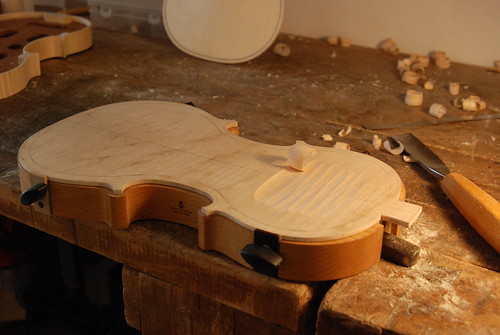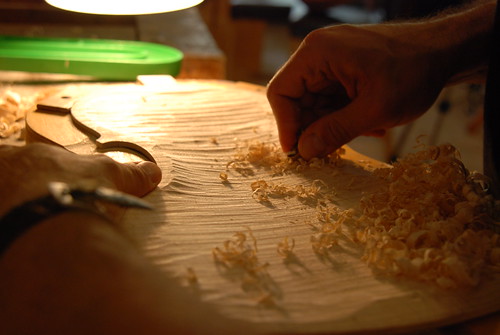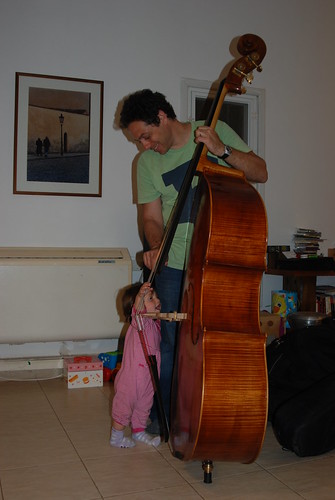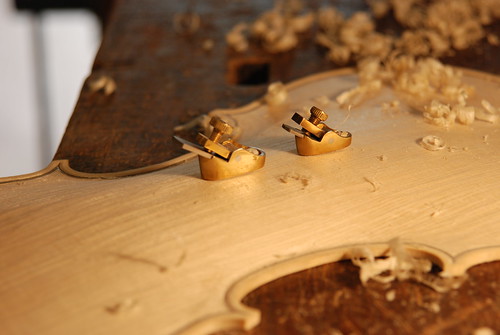
May 2012
Violin Maker's Wife: So - Spessori
May 28, 2012 05:53Post No. 15
I have been somewhat negligent of my blog (restructuring of our new home started last week, kids needed to be registered to new schools, etc. – all got in the way), and meanwhile Yonatan has been hard at work and, in addition to overseeing the restructuring process, is about half-way-through the thicknesses process. Lots to explain about this phase, so let’s get started:
As I mentioned last time, now that each of the fronts and backs have been carved from the outside into their rounded, curvy shape, Yonatan has been gauging out the inside of each, emptying it of wood and leaving an extremely exact thin layer of wood (doesn’t it sometimes seem like the wood of a violin was maybe bent into the shape it’s in? Well, now you know it’s actually carved out from a raw block of wood. Much more impressive I think!)
This ‘layer’ or ‘wall’ of wood, however, isn’t homogeneous throughout, changing between different segments of each ‘belly’ and each back.… complicated? I’ll try to explain -
Let’s take for example, the sounding board, (‘belly’ or “tavola” in Italian), of the cello. So Yonatan has a kind of “map” drawn that lists the various thicknesses throughout the belly’s plain. Usually, the belly is thicker – so more wood needs to remain – in its middle, and it’s thinner around the edges. The differences here – between so-called “thick” and “thin” areas – are tiny, not to say minute, just a few tenths of a millimeter (!!!) between say a “thick” section of 3.5mm and a “thin” section of 2.7mm, but this makes a hell of a difference.
For me there are two really interesting issues that come into play during Yonatan’s work on the Spessori (the Italian word for the “thicknesses” phase). The first is that here you can really understand the difference between a hand-made instrument, and a factory-made or serially-made one. Why? Because although each violin-making school has this type of “map” of thicknesses for the sounding board and back, Yonatan’s professionalism is to adapt this generic map to the specific characteristics of the piece of wood he is holding in his hand. Sometimes the wood is “softer” and more pliable, so he leaves just a bit more wood, making the sounding board thicker in the smallest degree. Other times, if he feels the wood of that specific instrument is rather “tough” or “hard”, he shaves off a tiny bit more wood, to compensate for that.
The second thing, which I guess is a recurring fascination of mine with the entire violin-making process, is how much PATIENCE this phase requires. At first, gouging out the wood is done with relatively rough gauges, but then the wood becomes really thin and Yonatan must use much more exact instruments – like the finger planes I mentioned before – to slowly and painstakingly reach the exact thickness he desires in each section of each front and each back…

And so he gauges out a tiny, thinnest layer, and then measures the thickness that remained with a special instrument that you can see in the picture here and then gently – very gently – flexes the wood to “feel it”…
Then he scratches away another tenth of a millimeter, and again measures the thickness of that specific section and tests the wood… and so forth –
You get the picture of how much PATIENCE this requires?? (an American artist-friend of mine once created this art piece once that she called “Pain in Patience”, in which she stuck hundreds of small needles in a stuffed surface to make the word ‘patience’ with the needles that made the letters of the word ‘pain’ sticking out further.) I am reminded of this because patience is one of the hardest things for me to master in this world and watching Yonatan’s seemingly ENDLESS PATIENCE during this phase always amazes me – and half makes me want to scream :)
Anyway – the Spessori for the backs (“fondi”) of the cello and the two violins have been completed, and so the back of the viola remains to be finished, as well as the sounding boards (“tavole“) of all four instruments. … but time waits for no one, and we have only less than five months to go till the deadline!
A couple of people have told me they like the pictures in this blog (so credit to Yonatan who finds innovative new ways of taking pictures even while he works…). Since I can only insert a couple here, check out the great photos we have uploaded to the Quartet Slideshow!!.
Violin Maker's Wife: Life is what happens when you're building a Quartet
May 20, 2012 11:31
This week Yonatan started a whole new phase in the construction of his Stringed Quartet, called “graduating the thicknesses” ('spessori' in Italian). If arching meant carving the external shape of each instrument’s front and back, then now Yonatan started gauging the inside of each plate (two per each instrument, remember?), taking out the wood until only an extremely thin layer remains, making the curvy, hollow shape of the violins, viola and cello.
I don’t know if you know this (I didn’t…) but the thickness of the violin’s body is amazingly thin – only a few millimeters – meaning that towards the end of the process extreme caution needs to be taken not to accidently break though the thin wood that remains (I remember one of the students in Yonatan’s class back at IPIALL in Cremona did this once – gauged a hole straight through his violin’s back… What a bummer:)).
This phase is hugely important as the thicknesses of the instrument’s plates (yes, thicknesses in plural – you’ll understand why next week:)) are maybe the major factor affecting its sound, resonance and playability. It’s also a phase that requires concentration and an ability to “understand wood” and will take the next couple of weeks. At least. So I was going to write all about it – but then LIFE happened, which meant that Yonatan ended up spending most of his time over the past two weeks working on something quite different. And that’s what I’ll write about this time.
What happened was this: Yonatan just finished constructing a brand-new, hand-made, mahogany-colored, amazing-sounding double-bass. Hand-making a double-bass is like … well, it’s actually a lot like hand-carving a pretty large closet from a raw block of wood…it takes about NINE MONTHS (Yonatan says it’s like a pregnancy… but what do MEN know about that?!?) Anyway, as he always does, when this masterpiece was finished, he started showing it to various musicians he knows, consulting with them and hearing their reactions to the new instrument. As he explained it to me “for me, building the instrument is the first part of ‘making’ it, while the second part is the interaction with musicians, which allows me to fine-tune the instrument, so really in the end it’s a joint creation of the builder and the player.”
Usually, fine-tuning an instrument is done by – as violin-makers say – “playing with the setup”, which to us mortals means changing some aspects of the bridge, strings or sound-post (just as bit of trivia: the sound-post, interestingly enough, is called in Italian the instrument’s “anima” or “soul”, and the same in Hebrew “neshama“). This time, however, Yonatan decided that a much more radical change was needed in order to reach the optimal sound and comfort from this beautiful double-bass. He decided to take its neck out, change some aspects of its measurements, and then insert it back in. If you think that’s an easy task – well, you’re wrong. Dead wrong.
Taking the neck out of any stringed instrument is a major decision, especially when it’s a newly finished one, because it often damages the instrument. Taking the neck of a double-bass out is a huge operation and requires about two weeks of work. So for Yonatan to take this decision was really tough – maybe like starting to break down walls in a newly finished, painted and furnished home; or needing to rewrite a chapter in an academic thesis you thought you had finally finished putting the last touches on; or … or maybe like deciding you are taking the draft of an entire post and trashing it… No. I guess the last example is a huge understatement…
Anyway, Yonatan debated this decision for a long time, until finally he decided that bringing this double-bass to optimal performance was worth the effort, and he went ahead and did it!
When the deed was done, everything glued back and all the varnish retouched and perfect once again, he brought the double-bass home and played it for me after the two older kids went to bed. He doesn’t play professionally or anything, but hearing those deep, deep vibrating notes coursing through our quiet home was very impressive. Little Alona, who is anything but a great sleeper, was still up and she, too, thought the double-bass sounded terrific…
Now it’s time to send this “baby” out into the world of musicians, orchestras and jazz, and see who grabs it first! You can see more picture of the double-base here!.
Violin Maker's Wife: Bombatura Part Two
May 15, 2012 06:15Post No. 13
You know the 80:20 rule? The one that says that 80% of any given work take about 20% of your time, and the remaining 20% of the work take up 80% of your time? I personally find that this rule applies to almost anything you need to accomplish in life, and apparently it is also true for the violin making process as a whole and each step within it specifically.
Last time I wrote about the Bombatura process – the arching process that defines the instruments’ external shape, volume and body – the heavy-duty work was basically done with, and the “only thing” that remained was to fine-tune the external shapes. Well, in addition to numerous other projects Yonatan has undertaken over the past three weeks or so, he has been working on this last 20% of the Bombatura process. As I wrote, special planes called “thumb planes” were used to carve the external arch of each instrument’s front and back. Below you can see two such planes during work on the viola. The trucioli – wood curls – they produce are very fine indeed.
Then, when all four instruments have reach the phase that their external arching has basically been shaped and carved, Yonatan uses a special scraper (rasiera in Italian) to fine-tune the shape even further, and actually to smoothen the surfaces as you would with a sandpaper. So why not sandpaper? you may ask. Well, there is apparently a WORLD of difference: while sandpaper sands wood by scratching its surface (thereby leaving…well… scratches on it), the scraper really cuts the wood’s surface, like the planes and gauges do, but in a very exact and minimal way, leaving the surface smooth and scratch-free.
When Yonatan first set up his workshop in our apartment in Cremona, this was one of the phases that blew me away – seeing his never-ending patience as he scrapes one thin layer of wood, and then another … and another still…. until finally the surface of each instrument becomes smooth and begins to glow so that the distinctive shapes and colors of the wood begin to really show.
Once this phase ended and all four instruments’ fronts and backs were smooth and shining, Yonatan put them away for a day or so. The next morning, he came into his workshop, lined all of them up (four instruments, times two pieces, so eight pieces all in all) and took “a fresh look” at them. He went once again over each of them, to check if the shape of the body is what he wanted to achieve, and made final corrections and modifications. Then, once again, he placed all of them next to one another and checked that the “line” he created has a common denominator for the entire Quartet.
And finally, as he did at the end of the “purfling” process, he attached each instrument’s front and back to the appropriate wooden mold, to make sure the pieces don’t bend out of shape from humidity, temperature changes etc. He uses special clamps for this purpose, that have rubber endings and do not harm the delicate wood, and when these claps are attached all around the instrument – smaller clamps around the smaller instruments, and larger ones around the mold of the cello – the instruments have a very particular look, as if there are snails or multiple eyes all around them… or maybe they actually look like the famous Barbapapa family!.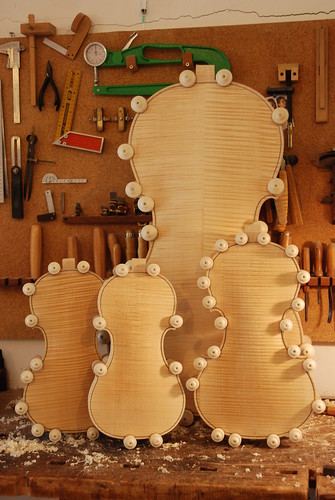
..it's been a while so check out lots of new picturs in the Quartet Slideshow!!.
Violin Maker's Wife: The Début of the Golden Viola
May 8, 2012 05:30
Remember I promised to tell you about the last phase of the Bombatura process? Well, that will have to wait till next week:)
But remember I promised to let you know when Yonatan’s Golden Viola – the one he built especially for his sister Galia – is played on stage? Well – that’s just what I am going to write about today.
After playing it for a while, to both “open” it and get used to its specific feel, measurements and sound, Galia started playing the Golden Viola everywhere – and being the extremely talented, sought-after and hard-working musician she is, it’s literally EVERYWHERE. So this past week alone, the viola has been featuring prominently in the Israeli The Voice program on TV (basically the only reason we have been watching it…), playing a major role in a new video clip, and featuring front and center in Rita’s new, extremely impressive concert.
We went to see the concert this past Friday night (thank god for kids-babysitting-grandparents), and I honestly can’t say what was more emotional: seeing Yonatan’s baby sister playing and singing front-and-center with one of Israel’s top stars, hearing his hand-made viola play so wonderfully and prominently, or seeing the light of pure joy in Yonatan’s eyes…
Talk about a sense of pride and fulfillment!
So this week, instead of writing, I’ll just let you take the time and enjoy this very original and beautiful clip of an Israeli group called (in free translation) “The Tractor’s Revenge”, which was filmed in one of the main squares of Tel-Aviv for the Indie-City project.
More entries: April 2012
Violinist.com is made possible by...
Dimitri Musafia, Master Maker of Violin and Viola Cases
International Violin Competition of Indianapolis
Violinist.com Holiday Gift Guide
Johnson String Instrument/Carriage House Violins
Subscribe
Laurie's Books
Discover the best of Violinist.com in these collections of editor Laurie Niles' exclusive interviews.

Violinist.com Interviews Volume 1, with introduction by Hilary Hahn

Violinist.com Interviews Volume 2, with introduction by Rachel Barton Pine

